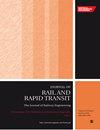Effect of unsupported sleepers on vertical levelling loss of heavy-haul railway track geometry under cyclic loadings
IF 2.1
4区 工程技术
Q3 ENGINEERING, CIVIL
Proceedings of the Institution of Mechanical Engineers Part F-Journal of Rail and Rapid Transit
Pub Date : 2024-07-22
DOI:10.1177/09544097241266289
引用次数: 0
Abstract
With an emphasis on the combined degradation of railway track geometry and components, an improved numerical approach is proposed for predicting the track geometrical vertical levelling loss (VLL). In contrast to previous studies, this research unprecedentedly considers the influence of unsupported sleepers (US) configuration on VLL under cyclic loadings, elasto-plastic behaviour, and different operational dynamic conditions. The nonlinear numerical models are performed adopting an explicit finite element (FE) package, and their results are validated by field data. The outcomes are iteratively regressed by an analytical logarithmic function that cumulates permanent settlements, and by a power function factor, which innovatively extends the response of US on VLL over a long term. Results shows that at 3 million cycles (or 60 MGT) the worst configuration for 20-ton axle load is at 5 US with 5-mm gap (5,51%), whereas for 30 and 40-ton axle loads is at 5 US with 2-mm gap (1.23% and 0,89%, respectively). This indicates that the axle load affects considerably the VLL as expected, however, the US condition plays an important role to accelerate it. Based on this study, the acceptable configuration of US can be specified for a minimum effect on VLL (thresholds) and, therefore, supports the development of practical maintenance guidelines to prolong the railway track service life.无支撑轨枕对循环荷载下重载铁路轨道几何形状垂直平整度损失的影响
本研究以铁路轨道几何形状和部件的综合退化为重点,提出了一种用于预测轨道几何垂直平整度损失(VLL)的改进型数值方法。与以往的研究不同,本研究前所未有地考虑了无支撑轨枕(US)配置在循环载荷、弹塑性行为和不同运行动态条件下对 VLL 的影响。非线性数值模型采用了显式有限元(FE)软件包,其结果通过现场数据进行了验证。其结果通过累积永久沉降的分析对数函数和幂函数系数进行迭代回归,创新性地扩展了美国对 VLL 的长期响应。结果显示,在 3 百万次循环(或 60 MGT)时,20 吨轴荷载的最差配置为 5 US、5 毫米间隙(5.51%),而 30 吨和 40 吨轴荷载的最差配置为 5 US、2 毫米间隙(分别为 1.23% 和 0.89%)。这表明,正如预期的那样,轴载对 VLL 有很大影响,但 US 条件对加速 VLL 起着重要作用。根据这项研究,可以指定对 VLL 影响最小的可接受 US 配置(阈值),从而支持制定实用的维护指南,以延长铁路轨道的使用寿命。
本文章由计算机程序翻译,如有差异,请以英文原文为准。
求助全文
约1分钟内获得全文
求助全文
来源期刊

CiteScore
4.80
自引率
10.00%
发文量
91
审稿时长
7 months
期刊介绍:
The Journal of Rail and Rapid Transit is devoted to engineering in its widest interpretation applicable to rail and rapid transit. The Journal aims to promote sharing of technical knowledge, ideas and experience between engineers and researchers working in the railway field.
 求助内容:
求助内容: 应助结果提醒方式:
应助结果提醒方式:


